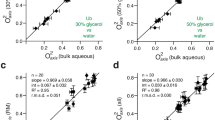Abstract
Both experimental and theoretical techniques1,2 for the study of the internal dynamics of globular proteins are being used to delineate the highly varied motional phenomena that can occur and to relate them to specific protein functions. The method of molecular dynamics has been shown to be a powerful theoretical tool for probing the internal motions on a subnanosecond time scale2–7. Previous calculations have, however, been restricted to a protein molecule in vacuum. To determine the effect of the environment on the dynamics, a protein in solution has been simulated with a simplified solvent model and the results compared with those obtained in vacuum and in a static crystalline environment. We report here that the presence of solvent, which results in a time-average structure closer to the native structure than the vacuum simulation, produces small alterations in the magnitudes and some changes in the decay times of the fluctuations in the interior of the protein; for surface residues, both the magnitude and the time course of the motions are altered significantly by the solvent.
Similar content being viewed by others
References
Gurd, F. & Rothgeb, T. M. Adv. Protein Chem. 35, 73–165 (1979).
Karplus, M. & McCammon, J. A. CRC Crit. Rev. Biochem. 9, 293–349 (1981).
McCammon, J. A., Gelin, B. R. & Karplus, M. Nature 267, 505–590 (1977).
McCammon, J. A., Wolynes, P. G. & Karplus, M. Biochemistry 18, 927–942 (1979).
Karplus, M. & McCammon, J. A. Nature 277, 578 (1979).
Levitt, M. in Protein Folding (ed. Jaeniche, R.) (Elsevier/North-Holland, Amsterdam, 1980).
Northrup, S. H., Pear, M. R., McCammon, J. A. & Karplus, M. Nature 286, 304–305 (1980).
Gelin, B. R. & Karplus, M. Biochemistry 18, 1256–1269 (1979).
van Gunsteren, W. F. & Karplus, M. J. Am. chem. Soc. (in the press).
Stillinger, F. H. & Rahman, A. J. chem. Phys. 57, 1281–1292 (1972).
Deisenhofer, J. O. & Steigemann, W. R. Acta crystallogr. B31, 238–250 (1975).
Ryckaert, J.-P., Ciccotti, G. & Berendsen, H. J. C. J. comput. Phys. 23, 327–341 (1977).
van Gunsteren, W. F. & Berendsen,H. J. C. Molec. Phys. 34, 1311–1327 (1977).
van Gunsteren, W. F. & Karplus, M. J. comput. Chem. 1, 266–274 (1980).
Gelin, B. R. & Karplus, M. Proc. natn. Acad. Sci. U.S.A. 72, 2002–2006 (1975).
Karplus, M. & Kushick, J. N. Macromolecules 14, 325–332 (1981).
Northrup, S. H., Pear, M. R., McCammon, J. A., Karplus, M. & Takano, T. Nature 287, 659–660 (1980).
Frauenfelder, H., Petsko, G. & Tsernoglou, A. Nature 280, 558–563 (1979).
Author information
Authors and Affiliations
Rights and permissions
About this article
Cite this article
van Gunsteren, W., Karplus, M. Effect of constraints, solvent and crystal environment on protein dynamics. Nature 293, 677–678 (1981). https://doi.org/10.1038/293677a0
Received:
Accepted:
Issue Date:
DOI: https://doi.org/10.1038/293677a0
- Springer Nature Limited
This article is cited by
-
SHAKE and the exact constraint satisfaction of the dynamics of semi-rigid molecules in Cartesian coordinates, 1973–1977
Archive for History of Exact Sciences (2023)
-
Influence of \( {\text{NH - }}{{\text{S}}^\gamma } \) bonding interactions on the structure and dynamics of metallothioneins
Journal of Molecular Modeling (2010)
-
About using the approximate fields to calculate the electrostatic potential distribution of membrane channels
Journal of Structural Chemistry (2005)
-
Polypeptide folding with off-lattice Monte Carlo dynamics: the method
European Biophysics Journal (1996)
-
Lattice mobility and anomalous temperature factor behaviour in cytochrome c′
Nature (1985)





